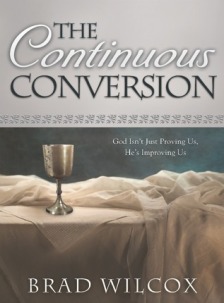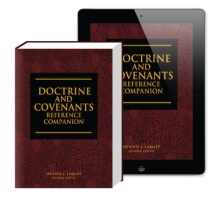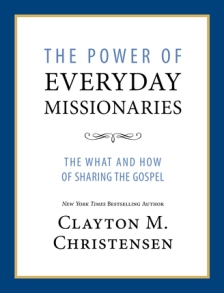
 In a delightful pair of books, popular LDS author and speaker Brad Wilcox (His Grace is Sufficient) outlines a generous perspective on our discipleship. Many of us have wryly noted that the bulk of the gospel is wound into that deceptively simple statement of the fifth step of eternal progression: endure to the end. While we have a great deal of guidance in the scriptures about how to be a better Christian, it can be easy to lose hope if the stories and guidance there seem cut and dried, and, in our darkest moments, out of reach.
In a delightful pair of books, popular LDS author and speaker Brad Wilcox (His Grace is Sufficient) outlines a generous perspective on our discipleship. Many of us have wryly noted that the bulk of the gospel is wound into that deceptively simple statement of the fifth step of eternal progression: endure to the end. While we have a great deal of guidance in the scriptures about how to be a better Christian, it can be easy to lose hope if the stories and guidance there seem cut and dried, and, in our darkest moments, out of reach.
The Continuous Atonement was released 4 years ago, and instantly readers felt the balm of an understanding perspective: we all fall short, even after our best efforts, and find ourselves repeating mistakes in discouraging cycles. That’s not only human; that’s the way the atonement works. Wilcox unwinds the stress associated with the atonement and exposes a rich and loving perspective that will be encouraging to those trapped by the myth of perfection. As he states in the chapter entitled “However Long it Takes,” grace is not a one-shot deal.
He also approaches the atonement as a healer instead of merely an eraser, a cleanser of intentional sin. In “He’s Got Us Covered” he comments,
A woman once asked, “Other than just being nice, why would Christ care about inadequacies, grief, sicknesses, and discouragement if such mortal experiences do not make us unclean?” Although they are not sins, many mortal experiences still have the potential to pull us far from God if not seen with the perspective provided by the plan of salvation. Too many raise an angry fist toward heaven and say, “Why me?” not realizing that in those very moments they need to extend an open hand toward heaven and plead for help….
If we but extend our hand to Him, He will take it. While many in the world see God’s help as having about the same effect as a rabbit’s foot or lucky charm, faithful Saints who make covenants with God in His holy house know the power that comes from feeling His hand in theirs.
All throughout the book, gentle perspective changes and pithy quotables nourish the reader’s spirit. While this classic is readable at the young adult level, its peaceful encouragement will meet many of us, much more weary from lives of trying too hard, with a cool drink of water and an engaging smile.
His follow-up book, The Continuous Conversion, just released last month, continues where he left off. In the author’s words,
I started writing The Continuous Atonement when I was serving as the bishop of a young single adult ward…. I realized that there was an aspect of the Atonement they didn’t get. They knew about how the Atonement could cleanse and console us, but they didn’t grasp how it can transform us and how Christ offers us His enabling power however long that transformation process takes–even continuously. This book picks up that same theme and answers the question, “How?” “How do I apply the Atonement and feel it’s transforming power on a continuous basis?” True conversion is not a onetime event, but a process that takes time. Most people accept that in theory, but we still beat ourselves up when we fall short. My message is “Be patient. You are doing better than you realize. Hang in there!” We are not paying our way into heaven. We’re practicing for it!
Opening this second book, linked together by beautiful images of the sacrament, the invitation to greater hope and encouragement to continuous effort feel very familiar. The tone carries over, and readers will recognize the pattern of memorable one-liners, quotes from General Authorities, and stories of Wilcox’s leadership service with others who, like us, struggle to feel converted. In addition, the most childlike questions are put forward in engaging ways, like this one:
If the whole goal is to be with God, why did we leave? We were with Him, but we were also painfully aware that we were not like Him physically or spiritually. We were willing to enter mortality because we knew that through the Atonement we could learn to be like Him. One of the miracles of the Atonement is not just that we can go home, but that we can feel at home there.
Chapters on why sacrifice is necessary for our conversion, learning (not earning) heaven, and why our obedience does not add to the finished work Christ has completed, fill out our knowledge and understanding of how to apply the atonement in our lives. If his previous work focused on building hope in our ability to access the atonement, this work focuses on how to work with the process of being converted by the atonement.
In a chapter sure to tickle your irony bone (Ladders, Train Tracks, and Callings), he addresses the many mixed messages we send and receive in Church culture.
Perhaps one of the most confusing of these mixed messages is when we are told that all callings are important, but then hear endless jokes about serving in the nursery. When was the last time you saw a brother invite his relatives to attend the sacrament meeting in which he was sustained as nursery leader and then stand up and say how humbled he felt when the call came?
 As with most of his writing, his gentle prose leads us to honest self-examination without feeling unduly chastised. A continuously, increasingly converted saint is more likely to change in this exploring environment. If you lead or teach people who can be prickly, immersing oneself in Wilcox’s tone can provide a useful means of tolerant correction.
As with most of his writing, his gentle prose leads us to honest self-examination without feeling unduly chastised. A continuously, increasingly converted saint is more likely to change in this exploring environment. If you lead or teach people who can be prickly, immersing oneself in Wilcox’s tone can provide a useful means of tolerant correction.
These are definitely classics I will keep close at hand to share with my teens, whose understanding of the atonement will likely take, as it does for all of us, a lifetime. Wilcox’s voice will be a pleasant addition to the others in their heads as they go forth to do their best.
If you’d like a taste of Wilcox’s style, you might enjoy the devotional referenced above. The parable of the piano lesson is one that reaches many people right where they are.














Posted on April 13, 2013
0